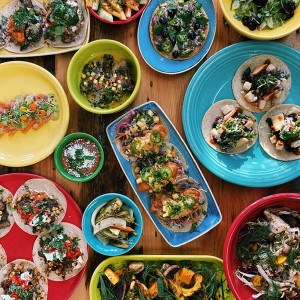The Kitchen Spy: Beacon Hill Bistro’s Joshua Lewin
In The Kitchen Spy, we visit local restaurant insiders’ home kitchens and force them to open up their fridge, drawers, and cabinets.

Photo by Fawn Deviney
As the executive chef of Beacon Hill Bistro, Joshua Lewin has the singular challenge of marrying the ingredients associated with the cuisines that inspire him—most recently, those of the Middle East and the American South—with those more typically associated with a 14-year-old, sorta-French, Charles Street bistro. As such, you’ll find roast chicken paired with spoon bread and fried okra, and Jordanian hummus in the same menu section as steak tartare. This interest in regional cuisines both home and abroad extends to his home kitchen in Inman Square, which is stacked with spices and cookbooks from the world over. Ahead, get a peek at some of these, and also learn about Lewin’s coffee habits, his prized kitchen tools, and the edible projects developing in his fridge.
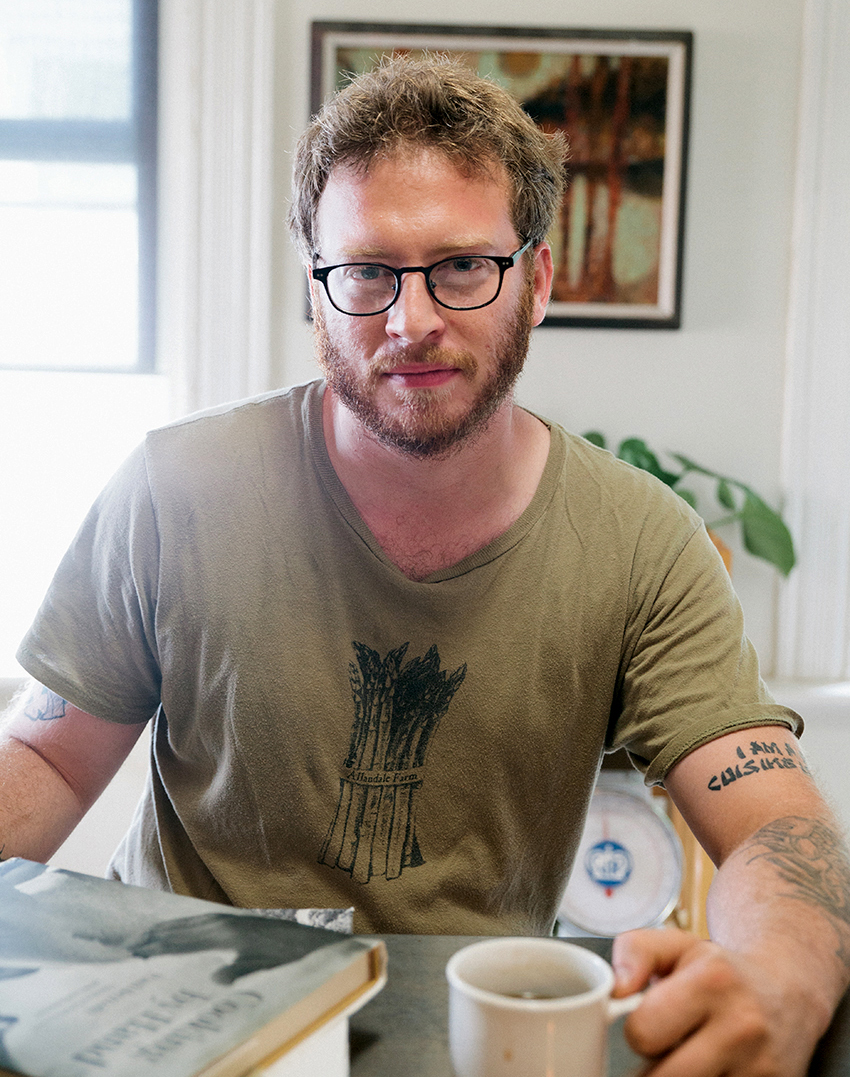
Photo by Fawn Deviney
“I enjoy cooking in it, but I don’t have enough time to cook regularly,” Lewin (above) says about his home kitchen. “I have a big kitchen island in the middle, and plenty of workspace.” Typical meals at home for Lewin include olives dusted with za’atar spice, various funky cheeses, lots of egg dishes, and mezze-style plates (“the things you stand around and enjoy,” he says). Sundays are for roasting, usually chicken or legs of lamb.
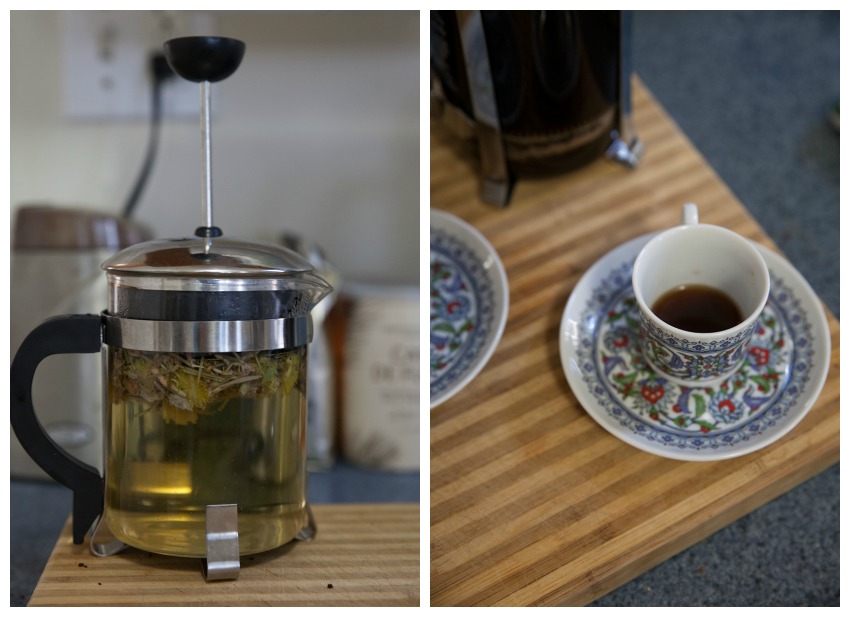
Photo by Fawn Deviney
Left: “That’s a dried wild herb tea from [Quebec specialty producer] Societe Original,” Lewin says. “I’m a big tea drinker; I drink coffee in the morning, and then tea all afternoon.” Right: As for that coffee? “I have been a French press person for about 10 years,” Lewin says. He drinks his coffee out of Turkish demitasse cups, purchased at the now-defunct Assalam Market on Prospect Street. “My coffee stays hotter if I drink it in small cups,” he says.
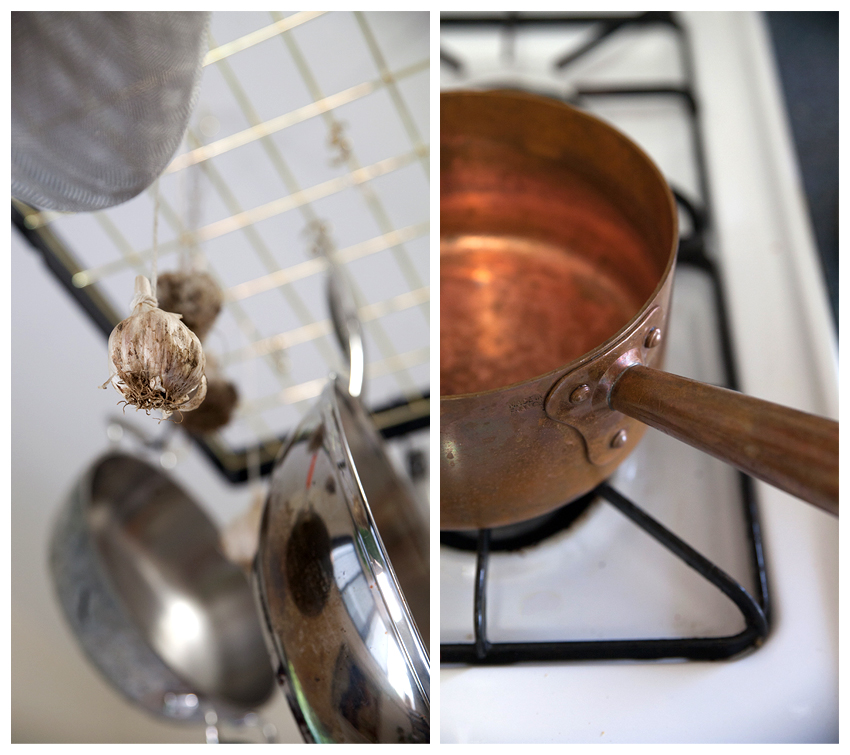
Photo by Fawn Deviney
Left: “That’s garlic that we cured at home,” says Lewin of the hanging bulb, though he says it mostly serves as decoration. Right: A copper sugar pot. “It’s really great for making sugar structures,” Lewin says. “It also heats up the water for my coffee really fast.”
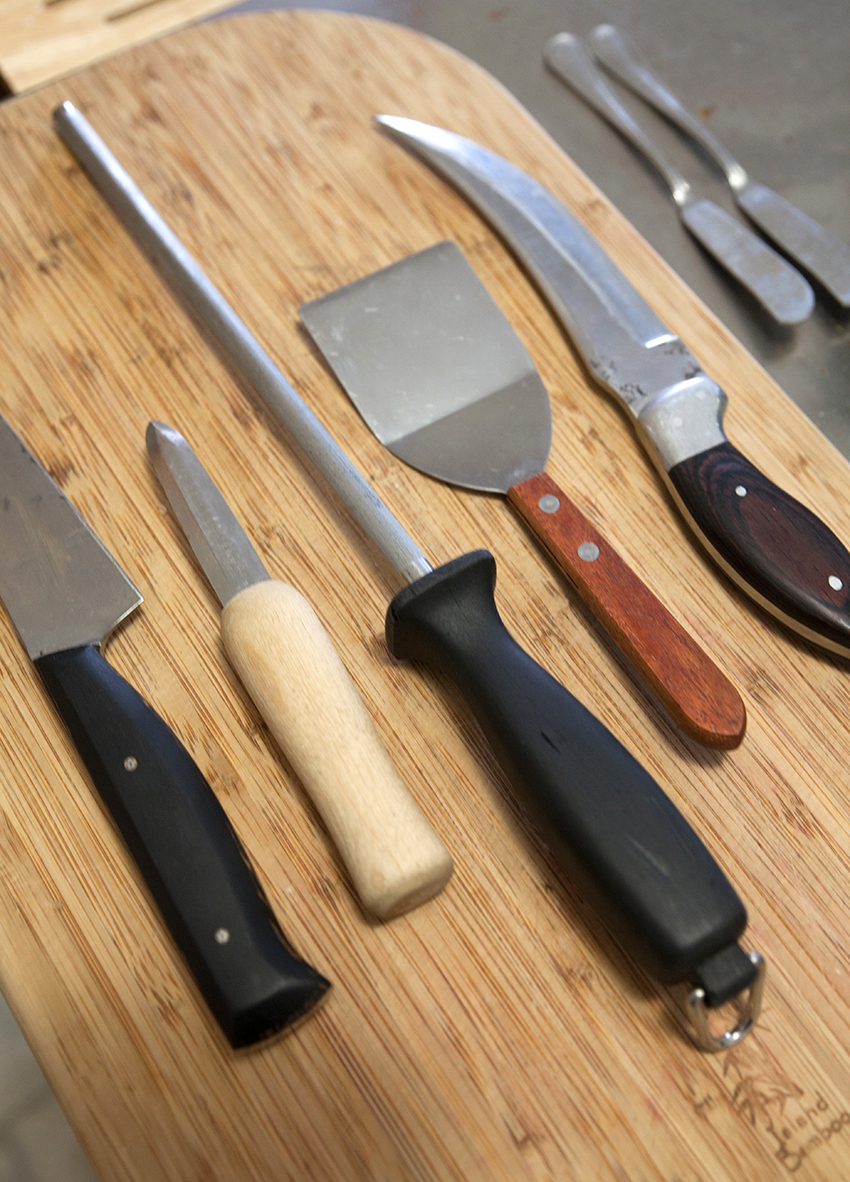
Photo by Fawn Deviney
Far left: The black handled, Japanese-steel knife at the far left was created by local craftsman Adam Simha. “I’m not sure how much money I will spend with him over the next few years, but I am sure it’s a lot,” Lewin says. Second from left: An oyster knife from Ayer-based company R. Murphy, which comes in handy for local snacking. “There’s a great little seafood place in Cambridgeport [Alive & Kicking Lobsters] and they hand you oysters and make you shuck them yourself,” Lewin says. Far right: A cimiter. “That’s something I might use for butchery,” Lewin says. “It’s a heavy-duty boning knife.”

Photo by Fawn Deviney
Clockwise from top left: 1. Dried beach roses from Eva’s Garden in Dartmouth. “They are only available for three weeks [out of the year],” Lewin says. “We buy 15 pounds of rose petals three times in early summer. We dry them to make rosewater, ice cream, and syrup. You can even freeze them fresh, if you toss them into citrus.” 2. Murray River pink salt from Australia. 3. The mezuzah (that has since been hung on the wall) was a gift. “That was made from re-purposed nuclear weapons. They call it ‘peace bronze,'” says Lewin, who is Jewish. “I thought that was a really cool concept—taking the weapons, and turning them into these cool little things.”
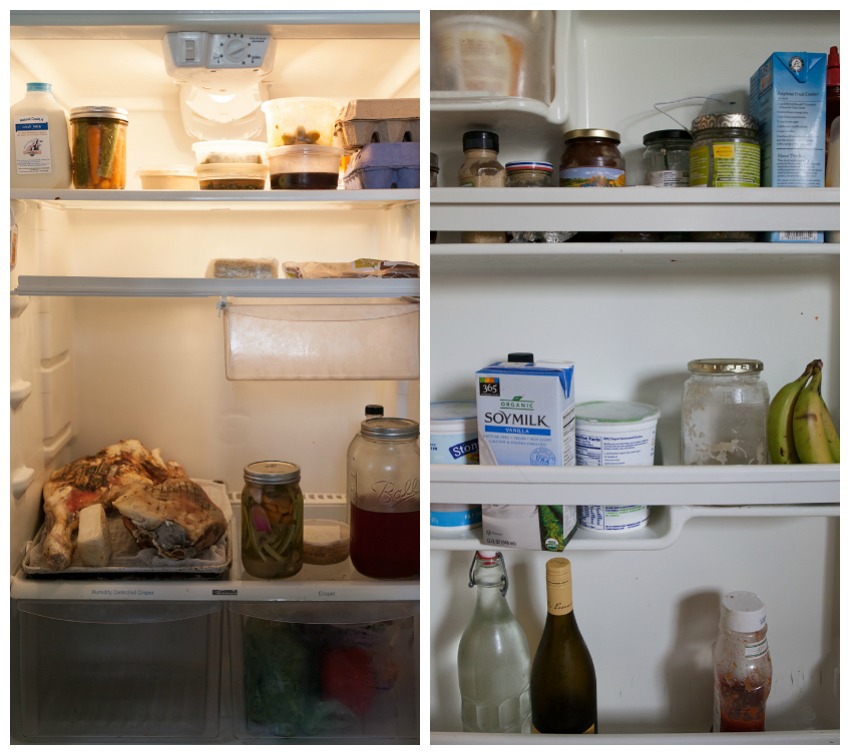
Photo by Fawn Deviney
While you’ll find some more common staples in the fridge like yogurt, soy milk, and mustard, there are some more enterprising projects as well, like two legs of mutton, chilling out until they become prosciutto. (Lewin also has some for-home-use projects in his basement, including salamis, and cured Mangalitsa pork legs.) Lewin says he also consistently stocks the fridge with olives from Al Bara on Prospect Street, and also farm-fresh eggs, sauerkraut, Sriracha, and mayonnaise. “I am not afraid to admit that I love mayonnaise and butter,” Lewin says. “Store-bought, I am a Hellman’s person, but I usually make it from scratch. Either way is very acceptable.”
On the top shelf of the fridge, there’s a gallon of goat’s milk. “I cook with it. It has a little more character than cow’s milk,” Lewin says. He’s also an avid pickler. “One weekend last year, I bought some assertive lettuce, and never got around to making the salad,” Lewin says. “I made lettuce jam out of it.”
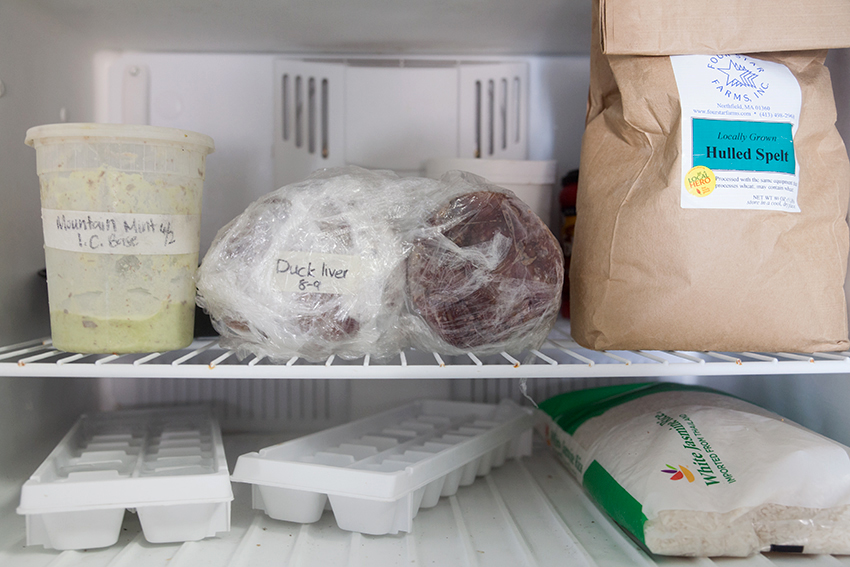
Photo by Fawn Deviney
Top shelf of the freezer, from left: 1. Some homemade mountain mint-chocolate chip ice cream. “I don’t eat a lot of sweets, but it’s nice to have some around,” Lewin says. “One nice way to use things up is to flavor some cream and make it into ice cream.” 2. Some frozen duck liver. “I like livers, but I hated them for a while,” Lewin says. “Those livers might have been meant for [my roommate’s] dog. They were making dog food for a while.” 3. Hulled spelt from Four Star Farms in Northfield. “I just play around with grains, they are really fun,” Lewin says.
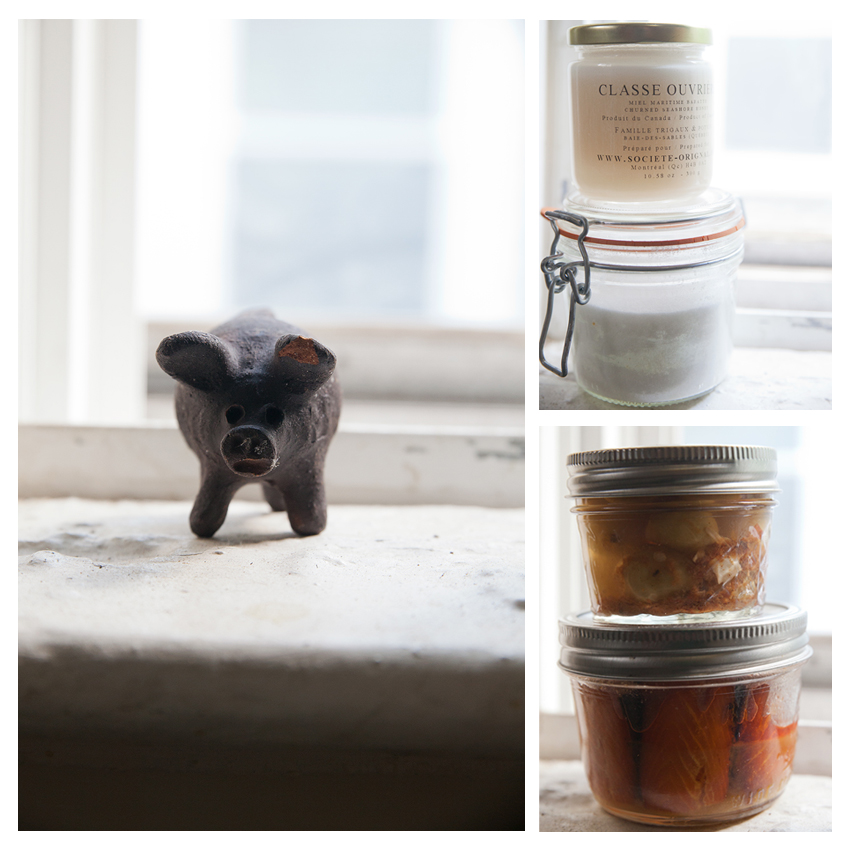
Photo by Fawn Deviney
Clockwise, from left: 1. A three-legged pig figurine, a gift from a friend. “They are a traditional sculpture in [Chile]. It’s a lucky pig. The story goes that on slaughter day, the pig was too fat for the farmer, so the farmer only got one leg. It’s a traditional children’s story.” 2. Wild honey from the same company that sells Lewin’s wild tea, Societe Original. “It’s white, and it comes from a shoreline in Quebec. It’s raw and almost a bit briny,” Lewin says. 3. In the bottom jar, there’s preserved salmon from Bristol Bay, Alaska. “I harp on Bristol a lot,” Lewin says. “A friend of mine is a young fishing boat captain [there]. I did some touring around the city with her when she was dropping into different congressmen’s offices and trying to garner support. She brought with her some of the preserved salmon from her home.”
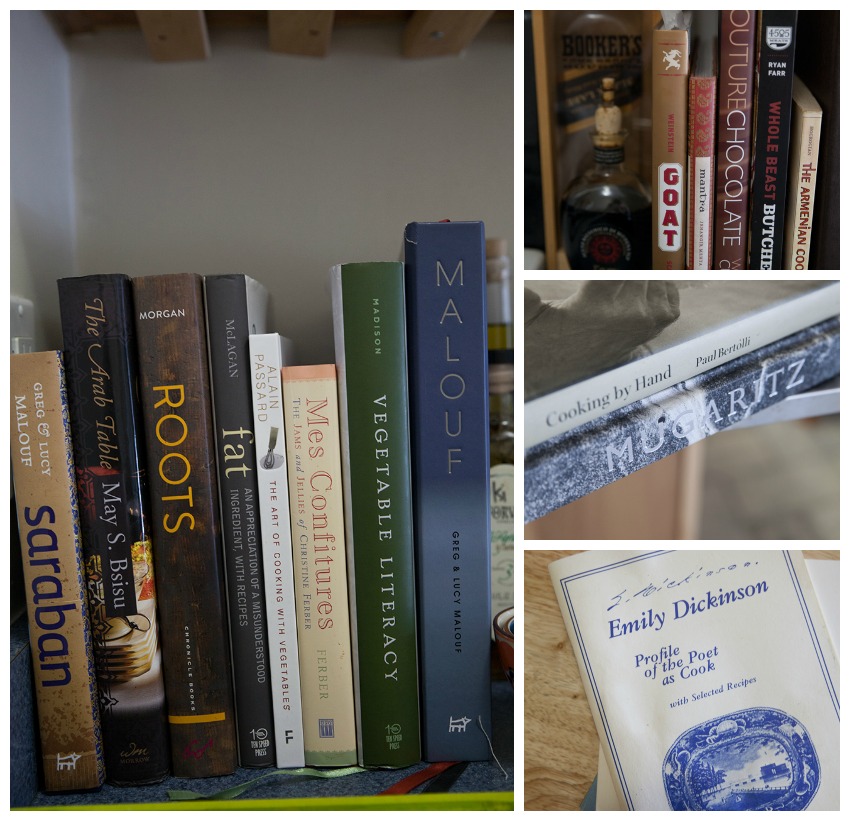
Photo by Fawn Deviney
Lewin stocks cookbooks that cover a host of techniques and cuisines. These are a few favorites:
• Malouf by George and Lucy Malouf: “Greg and Lucy are Australian chefs, and they do a lot of Middle Eastern cooking. I have never tasted any of it but it looks beautiful. I do a lot of Middle Eastern food, so I have them for inspiration.
• Vegetable Literacy by Deborah Madison: “It’s a fantastic book; buy it as soon as possible. It’s about the families of vegetables, and it’s more academic information which goes a long way when thinking about working with them.”
• Fat by Jennifer McLagan: “People are afraid of fat and everyone is on a diet, but we have forgotten how useful fats can be [for a dish to be] to be satisfying and delicious, and it’s not necessarily an evil thing. We do a lot of whole animal stuff [at Beacon Hill Bistro] too, so if you buy the whole thing you can’t be afraid to use the fat.”
• The Arab Table by May Bsisu: “It’s a good pan-Middle Eastern [cookbook]. It deals a lot with nomadic hospitality.”
• The Art of Cooking with Vegetables by Alain Passard: “I came up with a very meat-centric philosophy, and I am a great butcher,” Lewin says. “Until a couple of years ago, I wouldn’t have said the same about vegetables. This is about putting combinations of flavors together that can impress you as much as a great meat dish.”
• Mugaritz by Andoni Luiz Aduriz: “It’s really beautiful, really progressive, modern cuisine.”
• Cooking by Hand by Paul Bertolli: “That one is the cornerstone of what I always have done: simple, ground-up cooking; difficult recipes that result in very recognizable food. This had a big influence on me.”
• Goat by Bruce Weinstein: “We like to work with goats when we can [at Beacon Hill Bistro]. We source it whole from [Brooks Cloud farm] in Maine.”
• Profile of the Poet as Cook by Emily Dickinson: “It’s a fun little pamphlet written partially by Emily herself. It talks about different things she would do at home, just really basic New England cooking.”
• The Armenian Cookbook by Rachel Hogrogian: “One of my line staff is a first generation American and her father is from Armenia. That book belongs to her aunt, and we have been poring over it and imagining recipes. We are so familiar with Italian or French peasant cooking; we have been playing around with similar recipes in that book and seeing how to elevate them to that status.”
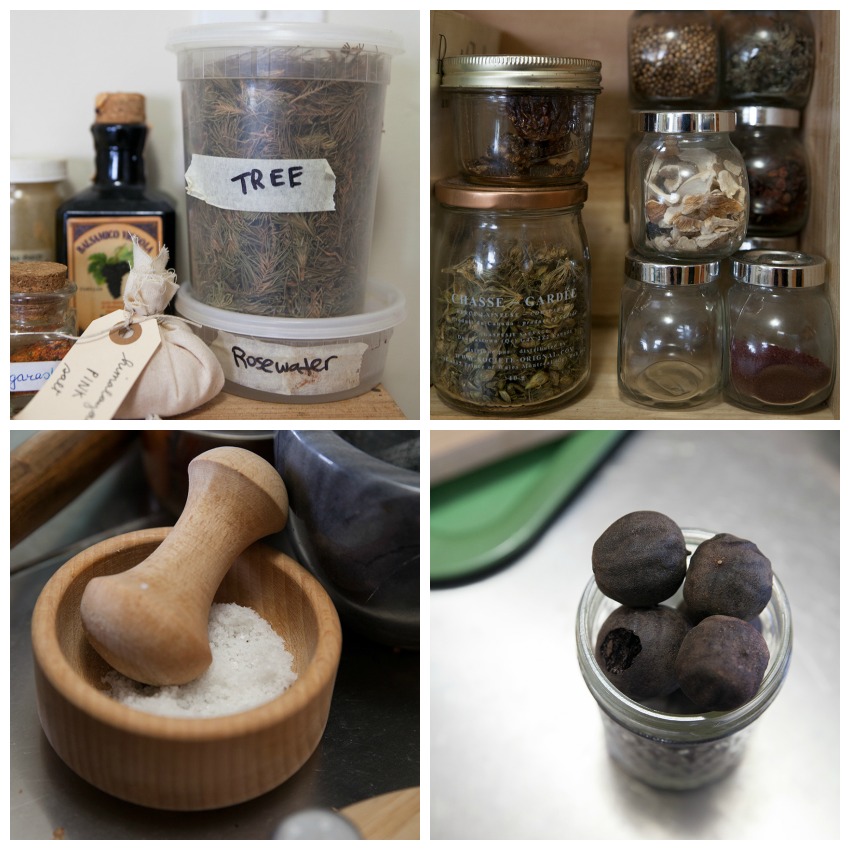
Photo by Fawn Deviney
Clockwise from top left: 1. The quart container labeled “tree” contains dried spruce. “I usually just use it like you would rosemary,” Lewin says. “It’s not by any means the same thing, but it works in a lot of places that you’d use rosemary.” Below that is a dish of rosewater, which Lewin folds into whipped cream and splashes onto berries. Also pictured: a tiny jar of togarashi, which Lewin uses regularly on eggs. 2. A selection of Lewin’s go-to spices, including sumac, dried mushrooms, and mustard seeds. 3. Dried black limes purchased at Christina’s spice shop, which is located near his apartment. “I know them from Persian cooking, but they are literally sun-dried limes, to preserve them,” Lewin says. “They are freaking delicious. You can grind them like a spice. If I am making a stock of a tomato-based soup or stew, I poke a hole in one and let it bob around until it sinks. It’s a fantastic bright flavor, better than fresh lime.”

